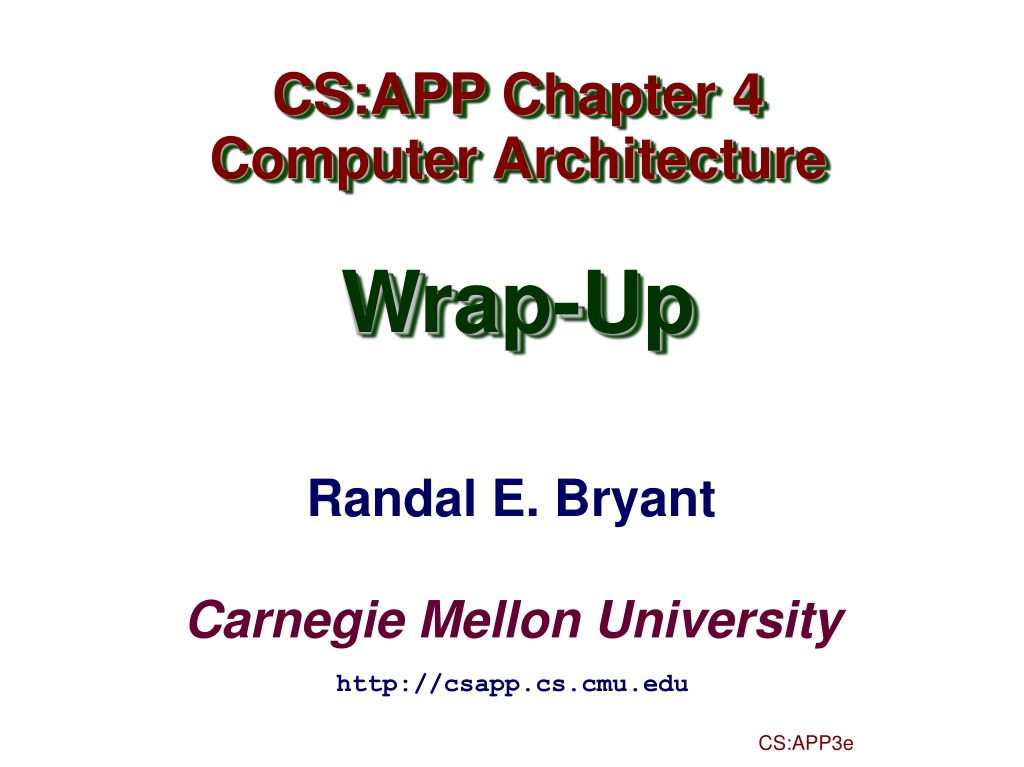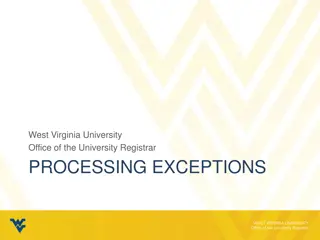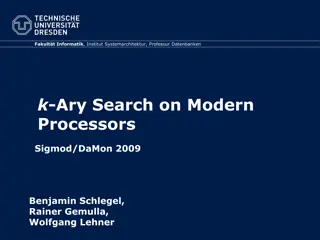- Understanding Exceptions in Modern High-Performance Processors
- Overview of exceptions in pipeline processors, including conditions halting normal operation, handling techniques, and example scenarios triggering exception detection during fetch and memory stages. Emphasis on maintaining exception ordering and performance analysis in out-of-order execution processors.
- - Computer architecture
- Processor exceptions
- Pipeline design
- Performance analysis
- Out-of-order execution
Download Presentation

Please find below an Image/Link to download the presentation.
The content on the website is provided AS IS for your information and personal use only. It may not be sold, licensed, or shared on other websites without obtaining consent from the author. Download presentation by click this link. If you encounter any issues during the download, it is possible that the publisher has removed the file from their server.
E N D
Presentation Transcript
CS:APP Chapter 4 Computer Architecture Wrap-Up Randal E. Bryant Carnegie Mellon University http://csapp.cs.cmu.edu CS:APP3e
Overview Wrap-Up of PIPE Design Exceptional conditions Performance analysis Fetch stage design Modern High-Performance Processors Out-of-order execution CS:APP3e 2
Exceptions Conditions under which processor cannot continue normal operation Causes Halt instruction Bad address for instruction or data Invalid instruction (Current) (Previous) (Previous) Typical Desired Action Complete some instructions Either current or previous (depends on exception type) Discard others Call exception handler Like an unexpected procedure call Our Implementation Halt when instruction causes exception CS:APP3e 3
Exception Examples Detect in Fetch Stage jmp $-1 # Invalid jump target .byte 0xFF # Invalid instruction code halt # Halt instruction Detect in Memory Stage irmovq $100,%rax rmmovq %rax,0x10000(%rax) # invalid address CS:APP3e 4
Exceptions in Pipeline Processor #1 # demo-exc1.ys irmovq $100,%rax rmmovq %rax,0x10000(%rax) # Invalid address nop .byte 0xFF # Invalid instruction code 1 2 3 4 5 Exception detected F D F E D F M E D F W M E D 0x000: irmovq $100,%rax 0x00a: rmmovq %rax,0x1000(%rax) 0x014: nop 0x015: .byte 0xFF Exception detected Desired Behavior rmmovq should cause exception Following instructions should have no effect on processor state CS:APP3e 5
Exceptions in Pipeline Processor #2 # demo-exc2.ys 0x000: xorq %rax,%rax # Set condition codes 0x002: jne t # Not taken 0x00b: irmovq $1,%rax 0x015: irmovq $2,%rdx 0x01f: halt 0x020: t: .byte 0xFF # Target 1 2 3 4 5 6 7 8 9 F D F E D F M E D W M E 0x000: xorq %rax,%rax 0x002: jne t 0x020: t: .byte 0xFF 0x???: (I m lost!) 0x00b: irmovq $1,%rax M W F D F E D M E W M W Exception detected Desired Behavior No exception should occur CS:APP3e 6
Maintaining Exception Ordering W stat icode valE valM dstE dstM M stat icode Cnd valE valA dstE dstM E stat icode ifun valC valA valB dstE dstM srcA srcB D stat icode ifun rA rB valC valP F predPC Add status field to pipeline registers Fetch stage sets to either AOK, ADR (when bad fetch address), HLT (halt instruction) or INS (illegal instruction) Decode & execute pass values through Memory either passes through or sets to ADR Exception triggered only when instruction hits write back CS:APP3e 7
Exception Handling Logic Fetch Stage dmem_error # Determine status code for fetched instruction int f_stat = [ imem_error: SADR; !instr_valid : SINS; f_icode == IHALT : SHLT; 1 : SAOK; ]; Memory Stage # Update the status int m_stat = [ dmem_error : SADR; 1 : M_stat; ]; Writeback Stage int Stat = [ # SBUB in earlier stages indicates bubble W_stat == SBUB : SAOK; 1 : W_stat; ]; CS:APP3e 8
Side Effects in Pipeline Processor # demo-exc3.ys irmovq $100,%rax rmmovq %rax,0x10000(%rax) # invalid address addq %rax,%rax # Sets condition codes 1 2 3 4 5 Exception detected F D F E D F M E D W M E 0x000: irmovq $100,%rax 0x00a: rmmovq %rax,0x1000(%rax) 0x014: addq %rax,%rax Condition code set Desired Behavior rmmovq should cause exception No following instruction should have any effect CS:APP3e 9
Avoiding Side Effects Presence of Exception Should Disable State Update Invalid instructions are converted to pipeline bubbles Except have stat indicating exception status Data memory will not write to invalid address Prevent invalid update of condition codes Detect exception in memory stage Disable condition code setting in execute Must happen in same clock cycle Handling exception in final stages When detect exception in memory stage Start injecting bubbles into memory stage on next cycle When detect exception in write-back stage Stall excepting instruction Included in HCL code CS:APP3e 10
Control Logic for State Changes Setting Condition Codes # Should the condition codes be updated? bool set_cc = E_icode == IOPQ && # State changes only during normal operation !m_stat in { SADR, SINS, SHLT } && !W_stat in { SADR, SINS, SHLT }; Stage Control Also controls updating of memory # Start injecting bubbles as soon as exception passes through memory stage bool M_bubble = m_stat in { SADR, SINS, SHLT } || W_stat in { SADR, SINS, SHLT }; # Stall pipeline register W when exception encountered bool W_stall = W_stat in { SADR, SINS, SHLT }; CS:APP3e 11
Rest of Real-Life Exception Handling Call Exception Handler Push PC onto stack Either PC of faulting instruction or of next instruction Usually pass through pipeline along with exception status Jump to handler address Usually fixed address Defined as part of ISA Implementation Haven t tried it yet! CS:APP3e 12
Performance Metrics Clock rate Measured in Gigahertz Function of stage partitioning and circuit design Keep amount of work per stage small Rate at which instructions executed CPI: cycles per instruction On average, how many clock cycles does each instruction require? Function of pipeline design and benchmark programs E.g., how frequently are branches mispredicted? CS:APP3e 13
CPI for PIPE CPI 1.0 Fetch instruction each clock cycle Effectively process new instruction almost every cycle Although each individual instruction has latency of 5 cycles CPI > 1.0 Sometimes must stall or cancel branches Computing CPI C clock cycles I instructions executed to completion B bubbles injected (C = I + B) CPI = C/I = (I+B)/I = 1.0 + B/I Factor B/I represents average penalty due to bubbles CS:APP3e 14
CPI for PIPE (Cont.) B/I = LP + MP + RP Typical Values LP: Penalty due to load/use hazard stalling Fraction of instructions that are loads Fraction of load instructions requiring stall Number of bubbles injected each time LP = 0.25 * 0.20 * 1 = 0.05 MP: Penalty due to mispredicted branches Fraction of instructions that are cond. jumps Fraction of cond. jumps mispredicted Number of bubbles injected each time MP = 0.20 * 0.40 * 2 = 0.16 RP: Penalty due to ret instructions Fraction of instructions that are returns Number of bubbles injected each time RP = 0.02 * 3 = 0.06 Net effect of penalties 0.05 + 0.16 + 0.06 = 0.27 CPI = 1.27 (Not bad!) 0.25 0.20 1 0.20 0.40 2 0.02 3 CS:APP3e 15
Fetch Logic Revisited During Fetch Cycle 1. Select PC 2. Read bytes from instruction memory 3. Examine icode to determine instruction length 4. Increment PC Timing Steps 2 & 4 require significant amount of time CS:APP3e 16
Standard Fetch Timing need_regids, need_valC Select PC Mem. Read Increment 1 clock cycle Must Perform Everything in Sequence Can t compute incremented PC until know how much to increment it by CS:APP3e 17
A Fast PC Increment Circuit incrPC High-order 60 bits Low-order 4 bits carry MUX 0 1 60-bit incre- menter 4-bit adder Slow Fast need_regids 0 High-order 60 bits need_ValC Low-order 4 bits PC CS:APP3e 18
Modified Fetch Timing need_regids, need_valC 4-bit add Select PC Mem. Read MUX Incrementer Standard cycle 1 clock cycle 60-Bit Incrementer Acts as soon as PC selected Output not needed until final MUX Works in parallel with memory read CS:APP3e 19
More Realistic Fetch Logic Other PC Controls Bytes 1-5 Bytes 1-9 Byte 0 Fetch Instr. Current Fetch Control Control Instr. Length Length Current Instruction Instruction Current Block Instruction Instruction Cache Cache Next Block Fetch Box Integrated into instruction cache Fetches entire cache block (16 or 32 bytes) Selects current instruction from current block Works ahead to fetch next block As reaches end of current block At branch target CS:APP3e 20
Modern CPU Design Instruction Control Instruction Control Address Fetch Control Retirement Unit Instruction Cache Instructions Register File Instruction Decode Operations Register Updates Prediction OK? Integer/ Branch General Integer FP Add FP Functional Load Store Mult/Div Units Operation Results Addr. Addr. Data Data Data Cache Execution Execution CS:APP3e 21
Instruction Control Instruction Control Instruction Control Instruction Control Instruction Control Address Address Fetch Control Control Fetch Retirement Retirement Unit Unit Instruction Instruction Cache Cache Instructions Instructions Register Register File File Instruction Instruction Decode Decode Operations Operations Grabs Instruction Bytes From Memory Based on Current PC + Predicted Targets for Predicted Branches Hardware dynamically guesses whether branches taken/not taken and (possibly) branch target Translates Instructions Into Operations Primitive steps required to perform instruction Typical instruction requires 1 3 operations Converts Register References Into Tags Abstract identifier linking destination of one operation with sources of later operations CS:APP3e 22
Execution Unit Register Updates Prediction OK? Operations Integer/ Branch General Integer FP Add FP Functional Load Store Mult/Div Units Operation Results Addr. Addr. Data Data Data Cache Execution Execution Multiple functional units Each can operate in independently Operations performed as soon as operands available Not necessarily in program order Within limits of functional units Control logic Ensures behavior equivalent to sequential program execution CS:APP3e 23
CPU Capabilities of Intel Haswell Multiple Instructions Can Execute in Parallel 2 load 1 store 4 integer 2 FP multiply 1 FP add / divide Some Instructions Take > 1 Cycle, but Can be Pipelined Instruction Load / Store Integer Multiply Integer Divide Double/Single FP Multiply Double/Single FP Add Double/Single FP Divide Latency Cycles/Issue 4 3 1 1 3 30 3 30 5 3 1 1 10 15 6 11 CS:APP3e 24
Haswell Operation Translates instructions dynamically into Uops ~118 bits wide Holds operation, two sources, and destination Executes Uops with Out of Order engine Uop executed when Operands available Functional unit available Execution controlled by Reservation Stations Keeps track of data dependencies between uops Allocates resources CS:APP3e 25
High-Perforamnce Branch Prediction Critical to Performance Typically 11 15 cycle penalty for misprediction Branch Target Buffer 512 entries 4 bits of history Adaptive algorithm Can recognize repeated patterns, e.g., alternating taken not taken Handling BTB misses Detect in ~cycle 6 Predict taken for negative offset, not taken for positive Loops vs. conditionals CS:APP3e 26
Example Branch Prediction Branch History Encode information about prior history of branch instructions Predict whether or not branch will be taken NT NT NT T Yes! Yes? No? No! NT T T T State Machine Each time branch taken, transition to right When not taken, transition to left Predict branch taken when in state Yes! or Yes? CS:APP3e 27
Processor Summary Design Technique Create uniform framework for all instructions Want to share hardware among instructions Connect standard logic blocks with bits of control logic Operation State held in memories and clocked registers Computation done by combinational logic Clocking of registers/memories sufficient to control overall behavior Enhancing Performance Pipelining increases throughput and improves resource utilization Must make sure to maintain ISA behavior CS:APP3e 28























